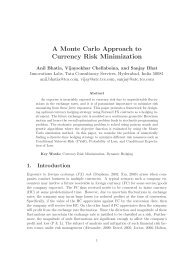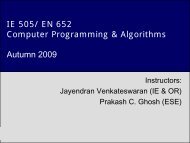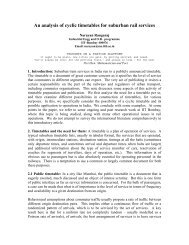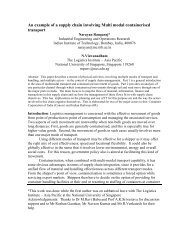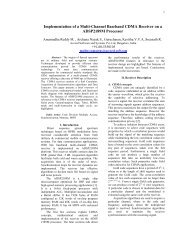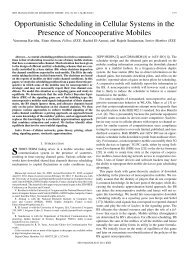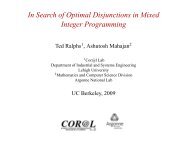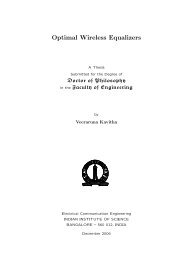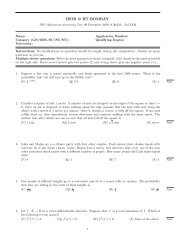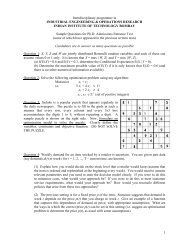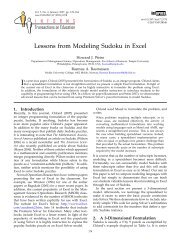Simulation of Multiple Line Rail Sections - IEOR @IIT Bombay ...
Simulation of Multiple Line Rail Sections - IEOR @IIT Bombay ...
Simulation of Multiple Line Rail Sections - IEOR @IIT Bombay ...
You also want an ePaper? Increase the reach of your titles
YUMPU automatically turns print PDFs into web optimized ePapers that Google loves.
ISCI 2012 10<br />
Table 4: Comparison <strong>of</strong> variable and fixed time strategies<br />
Time slots Nu Nd F ixedu F ixedd Variable<br />
0-6 7.727 3.818 13.032 16.799 13.712<br />
6-12 5.727 4.182 8.878 17.671 13.544<br />
12-18 4.636 8.727 11.801 14.127 14.172<br />
18-24 5.727 8.818 10.189 11.839 10.391<br />
respect to the other two, the location <strong>of</strong> crossover points, the traffic density, the traffic<br />
mix and finally the performance measures <strong>of</strong> relevance to the rail operator. <strong>Simulation</strong><br />
provides a good means for evaluating different strategies.<br />
In this paper we have reviewed the performance measures like, traffic intensity and<br />
weighted average traversal time which are used as the decision making parameters for the<br />
3 line railway section. <strong>Simulation</strong> also plays a major role in railway scheduling which has<br />
been done using the simulator developed by IIT <strong>Bombay</strong><br />
We experiment with the simple one <strong>of</strong> fixed time regimes and compare it with more<br />
complex strategies like variable time strategy involving some system state measures. More<br />
sophisticated control strategies using long run simulations can also be proposed and evaluated<br />
by other analytical techniques in future. The ones we have suggested have the<br />
advantage <strong>of</strong> being implementable with minimum additional infrastructure and training<br />
<strong>of</strong> personnel involved in the decision.<br />
Based on our experiments we can say that the WATT <strong>of</strong> fixed startegy is less than<br />
variable. More refined results can be obtained by analysing data for a variety <strong>of</strong> traffic<br />
and longer time which is a part <strong>of</strong> our future work.<br />
References<br />
[1] M. Abril, M. Barber, L. Ingolloti, M. A. Salido, P. Tormos, A. Lova A, “An assessment<br />
<strong>of</strong> railway capacity”, Transport. Res. Part E, 2007.<br />
[2] F. Barber, L. Ingolloti, M. A. Salido, “A <strong>Simulation</strong> tool to evaluate the robustness<br />
<strong>of</strong> railway timetables”, PSCS 2008.<br />
[3] Pratik V. Fadadu, “Network Level Investments to Improve <strong>Rail</strong> Capacity”, M.Tech<br />
Project Report, Industrial engineering and Operations Research, IIT <strong>Bombay</strong>, 2011<br />
[4] Jack B. Homer, Thomas E. Keane, Natasha Lukiantseva, David W. Bell, “Evaluating<br />
Strategies to Improve <strong>Rail</strong>road Performance - A System Dynamics Approach”, Winter<br />
<strong>Simulation</strong> conference, 1999<br />
[5] G. Raghuram and V. V. Rao, “A decision support system for improving railway line<br />
capacity”, Public Enterprise,Vol-11(1), pp.64-72 (1991).<br />
[6] N. Rangaraj, A. Ranade, K. Moudgalya, C. Konda, M. Johri and R. Naik “Simulator<br />
for <strong>Line</strong> Capacity Planning”, Sixth Asia Pacific Operations Research Society, Delhi,<br />
December 2003



